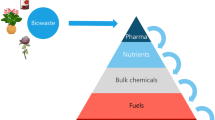Abstract
In this paper, we present applied methanol recycling technology utilising Chromatographic applications, which has been designed for an academic-size institution. The procedure is combined out of proper recovery technique and the biodegradation method intended for postprocessing residues. Additionally, analytical methods controlling the quality of the process are described in detail in order to enable full transfer of the proposed methodology to the analogous institution. The recovered solvent is of relatively high purity (> 99.92%), containing traces of water and volatile compounds. The spectral purity is sufficient to employ recycled methanol in HPLC applications where low wayelength detection is necessary. Biodegradation of distillation first-cuts and still bottoms is implemented using isolated strains ofMethylobacterium organophilum. During the biodegradation process, a series of carotenoids are biosynthesized, which are of a high commercial value. The proposed application, therefore, offers not only a sustainable, waste-free solution in handling methanol waste, but can also serve as a potential source of value.
Similar content being viewed by others
Literature
Baev MV, Kuznetsov EV, Skladnev DA, Govorukhina NI, Sterkin VE, Tsygankov YD (1992): Growth and enzymological characteristics of a pink-pigmented facultative methylotrophMethylobacterium sp. MB1. Folia Microbiol37, 93–101
Bradford MM (1976): A rapid and sensitive method for the quantitation of microgram quantities of protein utilizing the principle of proteindye binding. Analyt Biochem72, 248–254
DSMZ (1998): Catalogue of strains. Braunschweig, Germany
Goldberg I, Rokem J (1991): Biology of Methylotrophs. Butterworth-Heinemann, Stoneham, MA
Govindaswamy V, Vasudevan V, Divakar S (1999): Optimisation of growth parameters for the production of carotenoids byRhodotorula gracilis. Z Lebensm Unters Forsch A208, 121–124
Gu WL, Johnson EA (1997): Ethanol increases carotenoid production inPhaffia rhodozyma. J Indust Microbiol Biotechnol19, 114–117
Hirschberg J (1999): Production of high-value compounds: carotenoids and vitamin E. Curr Opin Biotechnol10, 186–191
Holland MA, Polacco JC (1994): PPFMs and other covert contaminants: is there more to plant physiology than just plant? Annu Rev Plant Physiol Plant Mol Biol45, 197–209
Huang RYM, Yeom CK (1990): Pervaporation separation of aqueous mixtures using crosslinked (polyvinyl alcohol). II Permeation of ethanol — water mixtures. J Membrane Sci51, 273
Korotkova N, Lidstrom ME (2001): Connection between poly-ß-hydroxybutyrate biosynthesis and growth on C1 compounds in the methylotrophMethylobacterium extorquens AMI. J Bacteriol183, 1038–1046
Lorenz TR, Cysewski GR (2000): Commercial potential forHaematococcus microalgae as a natural source of astaxanthin. Trends Biotechnol18, 160–167
Neto JM, Pinho MN, (2000): Mass transfer modelling for solvent dehydration by pervaporation. Separation Purification Technol18, 151–161
Pasternak M (1993): Separation of organic liquids. US Patent 5238573
Sandmann G, Albrecht M, Schnurr G, Knörzer O, Böger P (1999): The biotechnological potential and design of novel carotenoids by gene combination inEscherichia coli. Trends Biotechnol17, 233–237
Sato K, Mizutani T, Hiraoka M, Shimizu S (1982): Carotenoid containing sugar moiety from a facultative methylotroph,Protaminobacter ruber. J Ferment Technol60, 111–115
Stepnowski P, Blotevogel K-H, Ganczarek P, Fischer U, Jastorff B (2002): Total recycling of Chromatographic solvents — applied management of methanol and acetonitrile waste. Res Conserv Recycling (in press)
Streicher C, Kremer P, Thomas V, Hubner A, Ellinghorst G (1995): Development of new pervaporation membrane system and processes to separate alcohols/ether/hydrocarbons mixtures: Proc 7th Int Conf Pervaporation in the Chemical Industry, Nevada, p 297
Umweltbericht (2001): Umweltbericht der Universität Bremen. Sövegjarto D, Grundrum U, Stepnowski P (Eds): Universität Bremen, Deutschland pp 60
Van den Berg H, Faulks R, Fernando Granado H, Hirschberg J, Olmedilla B, Sandmann G, Southon S, Stahl W, (1995): J Sci Food Agric80, 880–912
Author information
Authors and Affiliations
Corresponding author
Rights and permissions
About this article
Cite this article
Stepnowski, P., Blotevogel, KH. & Jastorff, B. Applied waste-free recovery of methanol. Environ Sci & Pollut Res 9 (Suppl 1), 34–38 (2002). https://doi.org/10.1007/BF02987423
Received:
Accepted:
Issue Date:
DOI: https://doi.org/10.1007/BF02987423




